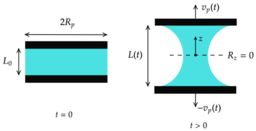Method for Characterization of Newtonian Fluids
TECHNOLOGY NUMBER: 2022-063

OVERVIEW
Characterization of multiple rheological properties in extension of Newtonian liquids- The approach improves upon an existing technique called capillary breakup rheometry (CBR)
- Can be used with existing instrumentation to measure sample viscosity and surface tension
BACKGROUND
Newtonian fluids are those that have a constant viscosity regardless of any applied shear rate or stress. Capillary breakup rheometry (CBR) is a traditional method for characterizing extensional properties of fluids that can form a liquid bridge. Capillary rheometers are primarily used for measuring the viscosity of suspensions and slurries containing relatively large particles, at high particle loadings such as polymer melts, ceramic slurries, foodstuffs, inks, and coatings. The method for CBR involves injection of a small amount of fluid into a thin capillary tube after which it is subjected to a slight, time-varying pressure pulse. This approach causes the fluid to stretch and then break into droplets, and the size and shape of these droplets can be analyzed to determine the fluid's viscosity and other properties. Capillary breakup rheometry is particularly useful for measuring the high shear rates that occur in many industrial processes, such as injection molding or extrusion, where the viscosity of the fluid is a critical parameter. The technique is also used in fundamental research to study the dynamics of fluid flow and the physics of droplet breakup. While CBR is advantageous over conventional rheometers because it does not require a force measurement, so it is useful for low-viscosity fluids where small forces are difficult to measure. Still, existing CBR technologies underpredict viscosity and are limited to dynamic viscosities of 70 millipascal seconds (mPa-s). So, a need exists for an improved CBR that is capable of overcoming these shortcomings.
INNOVATION
Researchers have developed a method for characterization of multiple rheological properties in extension of Newtonian liquids, including viscosity and surface tension. The modified procedure involves imposing an oscillatory deformation profile to a filament in a manner that improves upon existing methods for capillary breakup rheometry (CBR). This innovation involves imposing an oscillatory deformation profile to a filament initially placed between two parallel plates. This technology can be used with existing instrumentation, and it helps prevent filament break-up. Oscillation can be performed with optical photography such as capabilities included in smart phones to measure the filament diameter at midpoint. This approach can be used for the characterization of multiple rheological properties in extension of Newtonian liquids, and it has the potential to be developed to incorporate linear viscoelasticity. The set-up can be likely be extended to also include the measurement of a non-Newtonian relaxation time. Further modifications will seek to optimize the measurement of surface tension and viscosity ratios, permitting a better understanding of the limits of the proposed procedure.